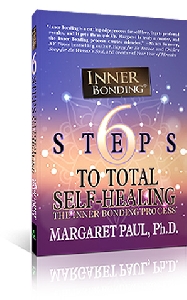The Purpose of Shame
By Dr. Margaret PaulDecember 31, 2006
Have you tried unsuccessfully to heal your shame? Discover the secret to healing shame.
 Many people on a healing path have found it extremely challenging to heal their shame. Yet when you understand the purpose of shame, you will be able to heal it.
Many people on a healing path have found it extremely challenging to heal their shame. Yet when you understand the purpose of shame, you will be able to heal it.
Shame is the feeling that there is something basically wrong with you. Whereas the feeling of guilt is about doing something wrong, shame is about being wrong at the core. The feeling of shame comes from the belief that, "I am basically flawed, inadequate, wrong, bad, unimportant, undeserving, or not good enough."
At some early point in our lives, most of us absorbed this false belief that causes the feeling of shame. As a result of not feeling seen, loved, valued, and understood, we developed the belief that we were not being loved because there was something wrong with us. While some children were told outright that they were not okay - that they were stupid, bad, or undeserving - other children concluded that there was something wrong with them by the way they were being treated.
Once we establish our core shame belief, we become addicted to it because it serves us in two primary ways:
1. It gives us a feeling of control over other people's feelings and behavior.As long as we believe that we are the cause of others' rejecting behavior, then we can believe that there is something we can do about it. It gives us a sense of power to believe that others are rejecting us or behaving in unloving ways because of our inadequacy. If is our fault, then maybe we can do something about it by changing ourselves, by doing things "right." We hang on to the belief that our inadequacy is causing others' behavior because we don't want to accept others' free will to feel and behave however they want. We don't want to accept our helplessness over others' feelings and behavior.
2. It protects us from other feelings that we are afraid to feel, and gives us a sense of control over our own feelings.
As bad as shame feels, many people prefer it to the feelings that shame may be covering up - loneliness, grief, heartbreak, sorrow, or helplessness over others. Just as anger may be a cover-up for these difficult feelings, so is shame. Shame is totally different than loneliness or grief or helplessness over others: While shame is a feeling that we are causing by our own false beliefs, loneliness, grief, heartbreak, sorrow, or helplessness over others are existential feelings - feelings that are a natural result of life. We feel grief and heartbreak over losing someone we love, or loneliness when we want to connect with someone or play with someone and there is no one around or no one open to connection, love or play. Many people would rather feel an awful feeling that they are causing, than feel the authentic painful feelings of life.
If you are finding it difficult to move beyond shame, it is because you are addicted to the feeling of control that your shame-based beliefs give you - control over others' feelings and behavior and control over your own authentic feelings. As long as having the control is most important to you, you will not let go of your false core shame beliefs.
You will heal from your shame when:
-
You are willing to accept that others' feelings and behavior have nothing to do with you. When you accept that others have free will to be open or closed, loving or unloving - that you are not the cause of their feelings and behavior and you no longer take others' behavior personally - you will have no need to control it. When you let go of your need to control others and instead open to compassion for yourself and others, you will let go of your false beliefs about yourself that cause the feeling of shame.
- You are willing to feel your authentic feelings rather than cover them up with anger or shame. When you learn to nurture yourself by being present with caring and compassion for your own existential feelings, you will no longer have a need to protect against these feelings with blame or shame.
Control and shame are intricately tied together.
When you give up your attachment to control and instead choose compassion toward yourself and others, you will find your shame disappearing. Giving up attachment to control is the result of practicing Inner Bonding. It takes a deeply devoted Inner Bonding practice to eventually let go of control.
Join Dr. Margaret Paul for her 30-Day at-home Course: "Love Yourself: An Inner Bonding Experience to Heal Anxiety, Depression, Shame, Addictions and Relationships."
 Send this article to a friend
Send this article to a friend  Print this article
Print this article  Bookmarked 27 time(s)
Bookmarked 27 time(s)
| Related Articles |
|---|
| Toxic Guilt, Healthy Guilt |
| Shame Busters |
| Healthy Guilt, Unhealthy Guilt |
| Guilt vs. Remorse |
| Embracing Our Dark Side: Healing Anger and Shame |
Comments
| Author | Comment | Date |
|---|---|---|
| Join the Inner Bonding Community to add your comment to articles and see the comments of others... | ||

Daily Inspiration
Do not be dismayed when you find yourself facing the same issues over and over. We all experience this - it is just different levels of the same soul's lessons. Each time, embrace the issues with compassion.
By Dr. Margaret Paul

 Share with Del.icio.us
Share with Del.icio.us Share with Digg
Share with Digg






